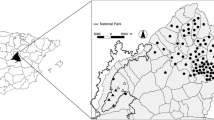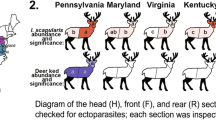Abstract
Invasion of the deer ked (Lipoptena cervi), an ectoparasitic fly commonly found in cervids, has been rapid in Finland during the last four decades. As the distribution area of this species has expanded from the south towards the northern latitudes, the associated problems have become more evident. Various animals such as horses, cattle and especially reindeer have been reported to host this parasite. Moreover, in certain areas, the deer ked causes major inconveniences for humans potentially limiting recreational activities in forests. We wanted to study if deer ked parasitism and intensity of the infection in winter time could be detected by using visual examination of the snow on cervid bedding sites and by analysing biotic samples found from the bedding sites. Our results demonstrate that chronic deer ked infection causes reddish-brown snow discolouration (host tissue fluid and deer ked faeces) on the bedding sites to the extent that parasitism can be diagnosed. Hence, we suggest that deer ked infection prevalence and range expansion could be rapidly monitored using our new practical and reliable method. In the future, bedding site analyses will likely be useful in predicting and potentially preventing the negative effects of this ecologically and socio-economically important parasite.



Similar content being viewed by others
References
Balashov YS (2007) Harmfulness of parasitic insects and acarines to mammals and birds. Entomol Rev 87:1300–1316
Bequaert JC (1953) The hippoboscidae or louse-flies (Diptera) of mammals and birds. Part 1. Structure, physiology and natural history. Entomol Am 32:1–209
Berriatua E, French NP, Wall R, Smith KE, Morgan KL (1999) Within-flock transmission of sheep scab in naive sheep housed with single infested sheep. Vet Parasitol 83:277–289
Broce A (2006) Ectoparasite control. Vet Clin North Am Food Anim Pract 22:463–474
Dehio C, Lanz C, Pohl R, Behrens P, Bermond D, Piemont Y, Pelz K, Sander A (2001) Bartonella schoenbuchii sp. nov., isolated from the blood of wild roe deer. Int J Syst Evol Microbiol 51:1557–1565
Dehio C, Sauder U, Hiestand R (2004) Isolation of Bartonella schoenbuchensis from Lipoptena cervi, a blood-sucking arthropod causing deer ked dermatitis. J Clinic Microbiol 42:5320–5323
Haarløv N (1964) Life cycle and distribution pattern of Lipoptena cervi (L.) (Dipt., Hippobosc.) on Danish deer. Oikos 15:93–129
Hackman W (1977) Hirven täikärpänen ja sen levittäytyminen Suomeen. Luonnon Tutkija 81:75–77
Hackman W, Rantanen T, Vuojolahti P (1983) Immigration of Lipoptena cervi (Diptera, Hippoboscidae) in Finland, with notes on its biology and medical significance. Not Entomol 63:53–59
Heikkinen S (2000) Hirven vuosi. Suomen Riista 46:82–91
Huber S, Bruns U, Arnold W (2002) Sex determination of red deer using polymerase chain reaction of DNA from faeces. Wildl Soc Bull 30:208–212
Ivanov VI (1974) On the damage done by Lipoptena cervi L. (Diptera, Hippoboscidae) in Byelorussia. Parazitologiya 8:252–253
Kadulski S (1996) Ectoparasites of Cervidae in north-east Poland. Acta Parasitol 41:204–210
Kaitala A, Kortet R, Härkönen S, Laaksonen S, Ylönen H (2008) Invasion of the moose ectoparasite Lipoptena cervi in Finland. In: Baskin LM (ed) Proceedings of the VIth International Moose Symposium. Yakutsk, pp 37–39
Kuhn C, Lucius R, Matthes HF, Meusel G, Reich B, Kalinna BH (2008) Characterisation of recombinant immunoreactive antigens of the scab mite Sarcoptes scabiei. Vet Parasitol 153:329–337
Laukkanen A, Ruoppi P, Mäkinen-Kiljunen S (2005) Deer ked-induced occupational allergic rhinoconjunctivitis. Ann Allergy Asthma Immunol 94:604–608
Maa TC (1969) A revised checklist and concise host index of Hippoboscidae (Diptera). Pacific Ins Monogr 20:261–299
Møller AP (1993) Ectoparasites increase the cost of reproduction in their hosts. J Anim Ecol 62:309–322
Mysterud A, Ostbye E (1995) Bedding-site selection by European roe deer (Capreolus capreolus) in southern Norway during winter. Can J Zool 73:924–932
Paakkonen T (2008) Hirvikärpänen ja sen vaikutukset hirveen ja poroon. In: RKTL, Riistapäivät 2008 Oulu 22–23.1., Kooste Riistapäivien esitelmätiivistelmistä. RKTL
Poulin R (1996) The evolution of life history strategies in parasitic animals. Adv Parasitol 37:107–134
Rantanen T, Reunala T, Vuojolahti P, Hackman W (1982) Persistent pruritic papules from deer ked bites. Acta Dermatol Venereol 62:307–311
Ratikainen II, Panzacchi M, Mysterud A, Odden J, Linnell JDC, Andersen R (2007) Use of winter habitat by roe deer at a northern latitude where Eurasian lynx are present. J Zool 273:192–199
Reid SA (2002) Trypanosoma evansi control and containment in Australasia. Trends Parasitol 18:219–224
Van den Broek AHM, Huntley JF, Halliwell REW, Machell J, Taylor M, Miller HRP (2003) Cutaneous hypersensitivity reactions to Psoroptes ovis and Der p 1 in sheep previously infested with P. ovis—the sheep scab mite. Vet Immunol Immunopathol 91:105–117
Wall R (2007) Ectoparasites: Future challenges in a changing world. Vet Parasitol 148:62–74
Yuval B (2006) Mating systems of blood-feeding flies. Annu Rev Entomol 51:413–440
Acknowledgements
We want to thank Kauko Kilpeläinen, Antti Leivo, Ari Junttila, Reijo Kotilainen and Pertti Rautio for their kind help during the experiment. This study was partly funded by the MAKERA and University of Oulu (RK). Our experiments comply with the current laws of Finland.
Author information
Authors and Affiliations
Corresponding author
Rights and permissions
About this article
Cite this article
Kaunisto, S., Kortet, R., Härkönen, L. et al. New bedding site examination-based method to analyse deer ked (Lipoptena cervi) infection in cervids. Parasitol Res 104, 919–925 (2009). https://doi.org/10.1007/s00436-008-1273-0
Received:
Accepted:
Published:
Issue Date:
DOI: https://doi.org/10.1007/s00436-008-1273-0




